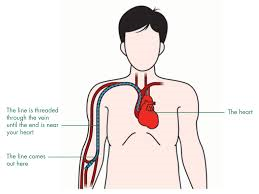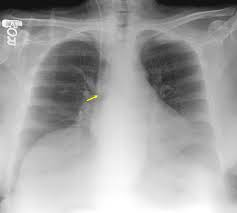After our intermediate diagnostic imaging studies practical session this week, which was based on mobile x-rays, and things that need to be taken into consideration by the radiographer before during and after they are called to take a mobile x-ray, I have decided to do my blog this week on the different kinds of lines that radiographers may be required to take an x-ray to check the position of. My blog this week is a descriptive blog, in preparation for my clinical placement in January and also to prepare me for my mobile appraisal, so that if I was called to x-ray to see one of these lines I will know what they are, and also what to look for on an x-ray critique. The lines that I am going to look at in this week’s blog are:
- Peripherally inserted central catheter (PICC line).
- Central Venous Catheter (Central Line).
- Nasogastric intubation (NG tube).
Peripherally Inserted Central Catheter.
A peripherally inserted central catheter is also known as a PICC line, it is a long thin flexible tube (Macmillan, 2014) that is inserted into a peripheral vein (PICC Line Nursing, 2014) that is usually in the upper arm above the elbow. The PICC line is then continually inserted into the vein until the tip of it reaches a large vein close to the heart (PICC Line Nursing, 2014).
(Macmillan, 2014)
A PICC line is inserted by a specialist PICC line Nurse that is trained to insert them, usually the vein in the upper arm is found by the use of ultrasound. After the PICC line is inserted, a chest x-ray is needed to confirm that the PICC line is in the correct place, the patient can either be x-rayed in the department or sometimes a portable x-ray is necessary (Raleighrad, 2014).
(Radiology Assistant, 2014)
If the tip of the PICC line is thought to be in the wrong position on the resultant image then it is possible for the specialist nurse to reposition it, and then another chest x-ray is required if again the tip is in the wrong position then the PICC line will be removed and reinserted (PICC Line Nursing, 2014).
A PICC Line is used as an intravenous (IV) line that can administer mediations, such as chemotherapy over a prolonged period of time.
Central Venous Catheter (Central Line).
A central venous catheter (central line) is a long flexible tube that is inserted into a vein in the chest or neck, It is then fed into the vein until the tip of the line lies within the proximal of the superior vena cava (Smith & Nolan, 2013).
(Macmillan, 2014)
The central line can be put in by a specialist nurse or doctor by using ultrasound to find a suitable vein. The patient is either given a local or general anaesthetic. After the central line is inserted a chest x-ray is then needed to check that the tip of the central line is in the correct position (MacMillan, 2014).
(Feldman & Gould, 2004)
The central line is used to give intravenous (IV) treatments such as chemotherapy, antibiotics and blood transfusions over a prolonged period of time.
Nasogastric Tubes (NG tubes).
A NG tube is a hollow bored tube that is fed through the nose into the stomach (Patient.co.uk, 2014), and is used for either short or long term nutritional support for the patient.
(Cancer Research UK, 2014)
After the NG tube has been inserted it needs to have the position of the tip checked, there are two ways of doing this; Firstly a PH test, by using blue litmus paper to check the acidity of the position of the tube – the typical acidity of the stomach is 4, and this should turn the litmus paper blue. Secondly an X-ray of the chest can be used to check the position of the NG tube, the x-ray should be collimated to include the stomach. The x-ray will pick up the position of the tip of the tube if the guide wire is left in (Patient.co.uk, 2014).
(Patient Safety Authority, 2014)
It is essential that the position of the NG tube is checked, as if it is wrongly inserted it can be fed into the bronchial tree or lung lobe (Patient Safety Authority, 2014), and if a patient is given nutritional support into the bronchial tree/lung lobe instead of the stomach then there can be dire consequences – such as patient death (Patient Safety Authority, 2014).
(Patient Safety Authority, 2014)
References.
Cancer Research UK, 2014. Cancer Research UK. [Online] Available at: http://www.cancerresearchuk.org/about-cancer/ [Accessed 17 November 2014].
Feldman, J. & Gould, M., 2004. Crossing The Line. [Online] Available at: http://webmm.ahrq.gov/case.aspx?caseID=51 [Accessed 17 November 2014].
MacMillan, 2014. Central Venous Lines. [Online] Available at: http://www.macmillan.org.uk/Cancerinformation/Cancertreatment/Treatmenttypes/Chemotherapy/Linesports/Centrallines.aspx [Accessed 17 November 2014].
Macmillan, 2014. MacMillan Cancer Support. [Online] Available at: http://www.macmillan.org.uk/Cancerinformation/Cancertreatment/Treatmenttypes/Chemotherapy/Linesports/PICCline.aspx [Accessed 19 November 2014].
Patient Safety Authority, 2014. Confirming Feeding Tube Placement. [Online] Available at: http://patientsafetyauthority.org/ADVISORIES/AdvisoryLibrary/2006/Dec3(4)/PublishingImages/23_Fig1.JPG [Accessed 17 November 2014].
Patient.co.uk, 2014. Patient.co.uk. [Online] Available at: http://www.patient.co.uk/doctor/nasogastric-ryles-tubes [Accessed 14 November 2014].
PICC Line Nursing, 2014. PICC Line Nursing. [Online] Available at: http://picclinenursing.com/picc_why.html [Accessed 17 November 2014].
Radiology Assistant, 2014. Radiology Assistant. [Online] Available at: http://www.radiologyassistant.nl/en/p526bd2e468b8c/neonatal-chest-x-ray.html [Accessed 17 November 2014].
Raleighrad, 2014. PICC Line and Port Placement. [Online] Available at: https://www.raleighrad.com/expertise/vein-vascular/picc-lines/ [Accessed 17 November 2014].
Smith, R. & Nolan, J., 2013. Central Venous Lines. British Medical Journal, 65(70), p. 347.








A concise blog that is a really good idea. It is good to see that you now know what the ‘wrong’ position looks as well as the correct. While you won’t be doing it for your appraisal, are there any differences for paediatric patients – different lines or positions?
LikeLike